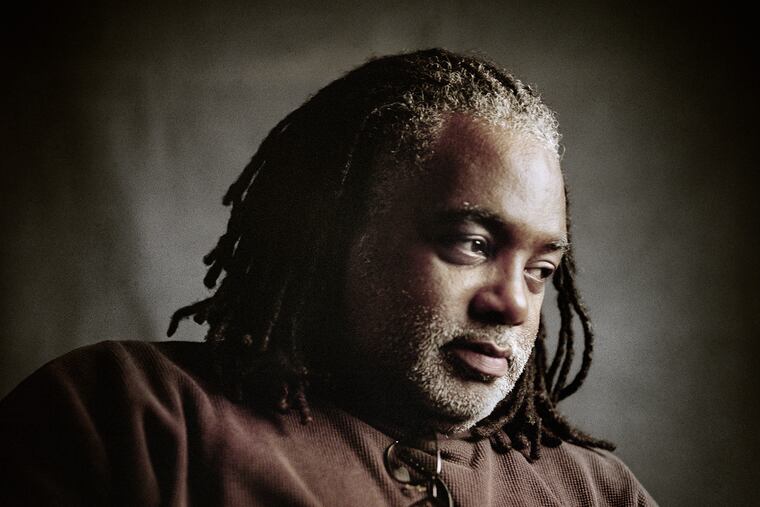Sentenced to death 3 times in 1989, Philly exoneree Harold Wilson dies at 61
Wilson became the sixth person exonerated from Pennsylvania’s death row, and spent his later years a staunch and outspoken death-penalty abolitionist.

Harold Wilson was convicted of a triple murder in a Philadelphia crack house in 1989, and sentenced to die three times. Instead, he fought for his life.
Wilson became the sixth person exonerated from Pennsylvania’s death row, and spent his later years a staunch and outspoken death-penalty abolitionist. He died May 18 of complications from a stroke. He was 61.
Despite 17 years in solitary confinement, he told a Democracy Now! interviewer in 2005, “I never gave them that opportunity to dehumanize me.”
He grew up on 18th Street in South Philadelphia, in a house spilling over with his five brothers and a sister, according to Avis Savage, a friend of 40 years. An entrepreneur, he had two children and a couple businesses before he was charged and convicted in the 1988 hatchet slaying of Dorothy Sewell, 64, her nephew Tyrone Mason, 33, and Mason’s girlfriend, Cynthia Goines Mills, 40.
“He was in shock for a long period of time. He didn’t understand how they were going to kill him three times,” Savage said.
At a time when capital cases were handled by notoriously underfunded and underprepared defense lawyers, Mr. Wilson’s attorney conducted little investigation into the case, according to Robert Dunham, who won him a stay of execution in 1996.
“His death sentence in 1989 was near the peak of death sentencing in Philadelphia,” said Dunham. In the ’90s, nearly 10 people were sentenced to death each year — in part, Dunham alleged, because prosecutors “routinely overcharged the death penalty in order to get the strategic advantage of a death qualified jury.”
Later, Mr. Wilson became the first person to challenge his conviction based on the now-infamous training tape featuring Jack McMahon, who was the prosecutor on his case, advising how race should play into jury selection. At an evidentiary hearing, Dunham said, lawyers presented an analysis of jury selection in that case, as well as decades of Philadelphia trials, that found stark racial disparities in jury composition and in outcomes for defendants: In eligible cases, the odds of imposing the death sentence increased 3.1 times if the defendant was black, and among cases that went to trial, black defendants were 9.3 times more likely than white counterparts to be sentenced to death.
The DA’s office retried the case twice: the second trial resulted in a mistrial, the third in acquittal. By then, DNA evidence showed a jacket covered in the victims’ blood — that Mr. Wilson had argued was not his and was far too small for his 6-foot-4 frame — also contained blood from a different person.
“He was on death row when the internet came to be and when cell phones came to be so he had a lot to learn when he came out. The world was a very, very different place," Dunham said. “He wasn’t able to work full time because of the PTSD he had developed as a result of his time on death row. But he … spoke about the death penalty all over the country.”
Mr. Wilson became involved with Witness to Innocence, a group of death-row-exonerees-turned-advocates. Kirk Bloodsworth, the executive director of the organization, said Mr. Wilson spoke to church groups, legislators, students and communities around the country, and returned each year to the steps of the U.S. Supreme Court to tell his story at an annual demonstration.
“He was a mountain of a man, not just in stature," Bloodsworth said. "That was his heart. The way he’d speak and the passion he had in his heart made him twice the size he was. The criminal justice system has a lot of problems, and Harold knew that — and knew there were many others left behind.”
McMahon, who is now a defense lawyer, said he has never stopped believing that Mr. Wilson was guilty, and he denies that he made racist jury strikes. “It was a black-on-black crime and there was no racial component to the case,” he said.
“But he was found not guilty so, it is what it is. Obviously, 12 people thought he was guilty back then, and 12 people thought he was not guilty later on.”
According to the National Registry of Exonerations, he received a $500,000 settlement from the city in 2016.
Wilson spent his final years in Accomac, Va., on the Eastern Shore, where he worked at a Walmart and a processing plant before he became disabled, according to Savage. He lived a quiet life, spending time in nature and with his family. He was clean to the point of fastidiousness; friends came to refer to him as “Monk” for his minimalist impulses.
But every chance he got, he gave interviews and spoke about his experience, alongside groups including the ACLU, Amnesty International, and Virginians for Alternatives to the Death Penalty.
He emphasized the conditions of confinement, which he likened to Abu Ghraib, and described receiving frequent discipline for covering the vents of his cell to block freezing air he believed was piped in as a subtle form of torture.
“He wasn’t bitter,” said Savage, “but he was very determined to let others know what the criminal justice system was like.”
The funeral service is scheduled for 11 a.m., Wednesday, May 29, at Mitchum-Wilson Funeral Home, 1410 S. 20th St., Philadelphia. The interment will be at Eden Cemetery in Collingdale.